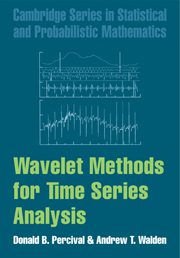Book contents
- Frontmatter
- Contents
- Preface
- Conventions and Notation
- 1 Introduction to Wavelets
- 2 Review of Fourier Theory and Filters
- 3 Orthonormal Transforms of Time Series
- 4 The Discrete Wavelet Transform
- 5 The Maximal Overlap Discrete WaveletTransform
- 6 The Discrete Wavelet Packet Transform
- 7 Random Variables and StochasticProcesses
- 8 The Wavelet Variance
- 9 Analysis and Synthesis of Long MemoryProcesses
- 10 Wavelet-Based Signal Estimation
- 11 Wavelet Analysis of Finite EnergySignals
- Appendix. Answers to Embedded Exercises
- References
- Author Index
- Subject Index
1 - Introduction to Wavelets
Published online by Cambridge University Press: 05 December 2013
- Frontmatter
- Contents
- Preface
- Conventions and Notation
- 1 Introduction to Wavelets
- 2 Review of Fourier Theory and Filters
- 3 Orthonormal Transforms of Time Series
- 4 The Discrete Wavelet Transform
- 5 The Maximal Overlap Discrete WaveletTransform
- 6 The Discrete Wavelet Packet Transform
- 7 Random Variables and StochasticProcesses
- 8 The Wavelet Variance
- 9 Analysis and Synthesis of Long MemoryProcesses
- 10 Wavelet-Based Signal Estimation
- 11 Wavelet Analysis of Finite EnergySignals
- Appendix. Answers to Embedded Exercises
- References
- Author Index
- Subject Index
Summary
Introduction
Wavelets are mathematical tools for analyzing time series or images (although not exclusively so: for examples of usage in other applications, see Stollnitz et al., 1996, and Sweldens, 1996). Our discussion of wavelets in this book focuses on their use with time series, which we take to be any sequence of observations associated with an ordered independent variable t (the variable t can assume either a discrete set of values such as the integers or a continuum of values such as the entire real axis - examples of both types include time, depth or distance along a line, so a time series need not actually involve time). Wavelets are a relatively new way of analyzing time series in that the formal subject dates back to the 1980s, but in many aspects wavelets are a synthesis of older ideas with new elegant mathematical results and efficient computational algorithms. Wavelet analysis is in some cases complementary to existing analysis techniques (e.g., correlation and spectral analysis) and in other cases capable of solving problems for which little progress had been made prior to the introduction of wavelets.
Broadly speaking (and with apologies for the play on words!), there have been two main waves of wavelets. The first wave resulted in what is known as the continuous wavelet transform (CWT), which is designed to work with time series defined over the entire real axis; the second, in the discrete wavelet transform (DWT), which deals with series defined essentially over a range of integers (usually t = 0, 1,…,N – 1, where N denotes the number of values in the time series). In this chapter we introduce and motivate wavelets via the CWT.
- Type
- Chapter
- Information
- Wavelet Methods for Time Series Analysis , pp. 1 - 19Publisher: Cambridge University PressPrint publication year: 2000
- 2
- Cited by



